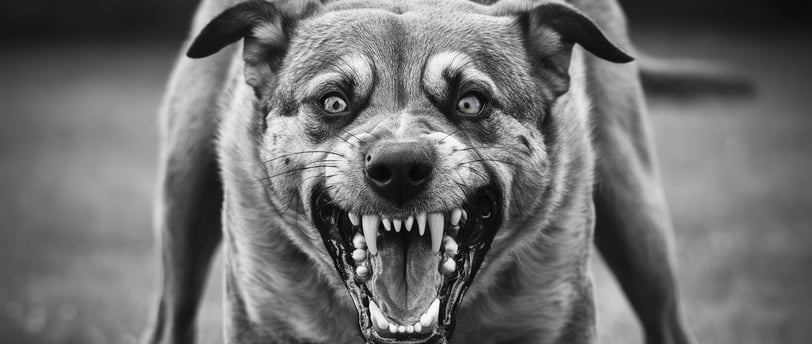Decode Your Dog: Understanding Canine Body Language
Ever wonder what your dog is really trying to tell you? In "Decode Your Dog," we break down common body language cues to help you understand your furry friend's emotions and needs. Strengthen your bond and improve communication with insights that make your relationship with your dog even more rewarding.
The Canine Chronicles
7/21/20245 min read


Ever wondered what your dog means when they tilt their head or wag their tail?
Dogs talk to us in many ways, just like humans do. By understanding their body language, you can get closer to your furry friend.
We'll explore the secret signs your dog uses to show how they feel. Let's dive into the world of canine communication.
Key Takeaways
Dogs communicate through a variety of body language cues, including tail wagging, ear position, and facial expressions.
Understanding your dog's body language can help you better interpret their emotions and needs.
Paying attention to subtle changes in your dog's demeanor can provide valuable insights into their state of mind.
By learning to "speak dog," you can build a stronger, more responsive relationship with your canine companion.
Decoding your dog's body language takes practice, but the rewards of improved communication are well worth the effort.
The Art of Reading Canine Communication
Learning to read a dog's body language is key for pet owners and dog lovers. The way a dog wags its tail is often misunderstood. It's not always a sign of happiness. Instead, it can tell us a lot about how they feel and what they want.
Check out my blog post to stop your dog pulling
Tail-Wagging: More Than Just Happiness
Many think a wagging tail means a dog is happy and excited. But it's more complex than that. Tail wagging can show different feelings, from joy to fear. The speed and direction of the wag are clues to their emotions.
A study showed dogs wag their tails more to the right when they're happy, like when they see their owner. But they wag to the left when they're not happy about something. The tail's position also tells us how they feel. An upright tail means they're confident, while a low tail means they're scared.
"To interpret the dog's emotions and intentions, look at the speed and direction of the wag, as well as the position of the tail."
By understanding dog tail positions and reading dog emotional states through tail movements, you can better understand your dog. This helps you interact with them in a way that meets their needs.


Getting good at interpreting dog tail movements and understanding dog tail positions strengthens your bond with your dog. By noticing these signs, you can show empathy and understand your dog's feelings better.
Interpreting Canine Body Postures
Understanding a dog's body postures is key to knowing their feelings and what they want. By watching how a dog stands or sits, we can learn a lot about their feelings. This helps us interact with them better.
Facial Expressions: The Key to Understanding
Dogs show their feelings through their faces. Some looks are clear, like a happy smile. But some are tricky, like a lip-lick showing discomfort, not happiness. A yawn might mean stress, not sleepiness.
Looking at a dog's body tells us a lot too. A cowering dog shows it's scared or stressed. A dog leaning forward might want to get closer, possibly to attack. The play bow, with the chest down and rump up, means they want to play.
Dog Body Posture - Cowering, Hunched Towards Ground
Possible Meaning - Fear or Stress
Dog Body Posture - Weight Shifted Forward
Possible Meaning - Trying to Get Closer, Potential Offensive Intentions
Dog Body Posture - Play Bow (Chest on Ground, Rump in Air)
Possible Meaning - Invitation to Play
By watching a dog's dog body postures and faces, we can understand them better. This helps us connect with our dogs on a deeper level. It makes our relationships with them stronger and more meaningful.


Understanding Canine Body Language
As pet owners, it's key to understand our furry friends' body language. This helps us connect better with them. By knowing how dogs communicate, we can guess their feelings and actions. This leads to a deeper bond and trust.
Dogs have their own way of talking through body language. It's full of signals that show their feelings and plans. We must look at the whole picture, from tail height to eye shape, to get the full message.
Learning to read these cues lets us see how our dogs feel. It helps us stop problems before they start. This makes our relationship with our dogs stronger and more peaceful.
Your dog talks to you all the time through body language. By listening, you can get closer to your dog. This way, you can meet their needs and make your bond even stronger.
Exploring the Language of Tails
The tail is a key part of how dogs communicate. Its height, speed, and movement tell us a lot about their feelings. A wagging tail means they're happy, while a tucked tail shows they're scared or submissive.
Tail Position - High and Wagging
Emotional State - Friendly, Excited
Tail Position - Low and Tucked
Emotional State - Fearful, Submissive
Tail Position - Stiff and Erect
Emotional State - Aggressive, Dominant
Tail Position - Slowly Wagging
Emotional State - Uncertain, Cautious
Knowing about tail language helps us understand our dogs better. It makes our communication stronger. This builds a deeper bond between us.
Conclusion
Learning to read my dog's body language is key to a stronger bond with my pet. By watching their tail, ears, eyes, head, and posture, I can understand their feelings and what they want. This helps me talk better with my dog and meet their needs, making our relationship deeper and more trusting.
Getting good at reading canine body language is rewarding for both me and my dog. It's important to know how to read my dog's cues and use body language to connect better with them. This makes our life together happier and more in tune.
As I learn more about my dog's body language, I'm sure our bond will keep getting stronger. I'll be able to understand my dog better and connect with them in a deeper way. This knowledge lets me handle my dog's behavior with ease and strengthen our special bond.
FAQ
What is the importance of understanding canine body language?
Knowing your dog's body language is key to a strong bond and clear communication. By watching their tail, ears, eyes, head, and posture, you learn about their feelings and plans. This helps you meet their needs better.
How can I interpret a dog's tail-wagging?
A wagging tail doesn't always mean a happy dog. The speed and direction of the wag, plus the tail's position, tell you a lot. A fast wag to the right shows happiness, while a left wag might mean sadness.
What do different dog body postures and facial expressions mean?
A dog's posture and face can show many feelings and plans. A cowering dog is likely scared or stressed. A dog leaning forward might want to get closer, possibly with bad intentions. Yawning or lip-licking can also show how they're feeling.
How can I develop a deeper understanding of my dog's body language?
To really get your dog's body language, watch their whole communication. This includes their tail, ears, eyes, head, and posture. Learning these signals helps you guess their actions, avoid issues, and build trust with your dog.
Source Links
Thanks and best regards
The Canine Chronicles
Click the link below for a free ebook to train your dogs brain.
This post may contain affiliate links. If you make a purchase through one of these links, we may earn a small commission at no additional cost to you. We only recommend products and services that we have personally used and believe will add value to our readers. Your support helps us continue to provide valuable content. Thank you for your support!
